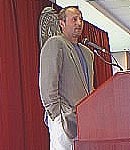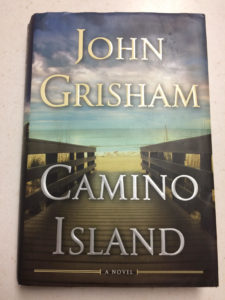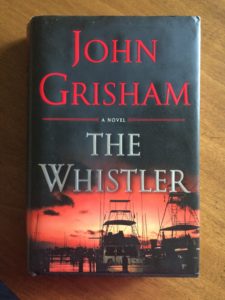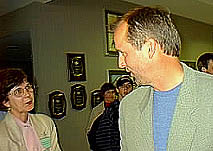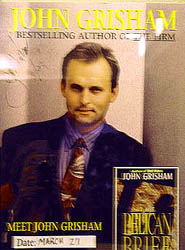Major Works
- A Time for Mercy: Jake Brigance Book 3 (Oct. 13, 2020)
- Camino Winds (April 20, 2020)
- The Guardians (Oct. 15, 2019)
- The Reckoning (2018)
- The Rooster Bar (2017)
- Camino Island (2017)
- The Whistler (2016)
- Rogue Lawyer (Oct. 2015)
- Theodore Boone: The Fugitive (2015)
- Gray Mountain (2014)
- Sycamore Run: Jake Brigance Book 2, (2013)
- Theodore Boone: The Activist (2013)
- Theodore Boone: The Accused (2013)
- Fetching Raymond (2013)
- Theodore Boone: The Abduction (2012)
- Calico Joe (2012)
- The Racketeer (2012)
- The Brethren (2012)
- The Litigators (2011)
- Bleachers (2011)
- The Testament (2011)
- The Confession (2010)
- Theodore Boone: Kid Lawyer (2010)
- The Street Lawyer (2010)
- The Associate (2009)
- Ford County: Stories (2009)
- The Appeal (2008)
- Playing for Pizza (2007)
- The Broker (2005)
- The Innocent Man (2006) Non-fiction
- The Last Juror (2004)
- The King of Torts (2003)
- Bleachers (2003)
- The Summons (2002)
- Skipping Christmas (2001)
- A Painted House (originally published in six issues of The Oxford American) (2001)
- The Brethren (February, 2000)
- The Testament (1999)
- The Street Lawyer (1998)
- The Partner (1997)
- The Runaway Jury (1996)
- The Rainmaker (1995)
- The Chamber (1994)
- The Client (1993)
- The Pelican Brief (1992)
- The Firm (1991)
- A Time to Kill (1989)
Biography of John Grisham
by Sean Hosie (SHS)
John Grisham was born on February 8, 1955 in Jonesboro, Arkansas, but he graduated from high school in Southhaven, Mississippi, and lived for many years in Mississippi. He wanted to be a great baseball player and a future Hall of Famer (Grisham 1991 2). so he went to Delta State in Cleveland, Mississippi, where the competition was harder, and he found he could not hit a fast ball or curve ball well. He knew that pitchers were cruel when they spotted weaknesses. His roommates were restless, and since his baseball career was over anyway, John and his friends left Delta State at the end of the semester and went to Mississippi State University in Starkville, Mississippi.
At MSU, the friends started out in forestry. They had already decided that if things did not work out, they would go to Appalachian State. One of his friends wanted to see the mountains. At first Grisham did not like Mississippi State; he was not interested in learning. He had transferred from two schools, and he did not have very good grades. Almost immediately, he changed his major to economics.
In his first economics class, he witnessed a class discussion of students and the instructor in which the students were articulate, prepared, and unafraid of confronting the professor. He wanted to be part of that. He wanted to grow up and learn (Grisham. 1991. 3). He discovered that he preferred accounting to economics. His grades were salvageable. With hard work he thought he could succeed. He also had thoughts of attending law school. If he did not get in, he would still have an excellent degree from Mississippi State University . (Grisham 1991 3). Grisham graduated with a B.S. in accounting from Mississippi State University in 1977.
Grisham then studied tax law at the University of Mississippi in Oxford, Mississippi. Discovering that he did not like that specialty, he changed to criminal law. He graduated in 1981 with a law degree and opened a law practice in Southaven, Mississippi. He practiced law for almost a decade and specialized in criminal defense and personal injury Litigation. His experiences with judges, courts and police have been useful in writing his novels (Grisham 1992b 3) .
In 1983 the voters of Mississippi’s Seventh District elected John Grisham to represent them in the Mississippi House of Representatives in Jackson. He began writing fiction in 1984 while in the legislature and finished his first book A Time to Kill in 1987. However, it was prejudged a regional novel and received little national attention (Mitchell Memorial Library 2). The initial printing was for 5,000 copies and he sold 1,000 copies to his friends and acquaintances in Mississippi.
The same year he began working on a new book, The Firm, and in 1990 Paramount Pictures paid him $600,000 for the rights to his new book (Grisham 1993 2-4). The book, published in 1991 by Doubleday, spent forty-seven weeks on the NewYork Times best seller list. John Grisham’s writing career skyrocketed and brought him international fame. Grisham served two terms as a Mississippi state representative. In his second term he held positions on important House committees and was vice chairman of the Appointment and Elections Committee. Sometimes bored by the frequent inactivity of the legislature, he introduced a resolution commending Herbert Khaury (who in actuality was really Tiny Tim)! He served in the legislature until 1990.
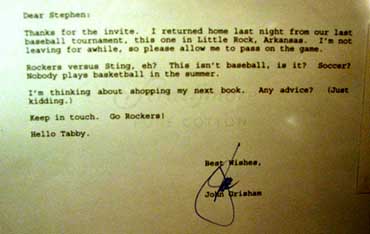
Letter above from Grisham Room exhibit in Mitchell Library, Mississippi State University. Letter is to Stephen King from John Grisham.
Grisham’s first book, A Time to Kill, is the story of a young rape victim, a ten-year-old black girl, in Clanton, Mississippi, and the revenge taken by her father. A major section of the book is the trial that results after the father kills both men charged with the rape as they leave the courtroom. Grisham’s story was sparked by a trial he had witnessed in Hernando, Mississippi (Grisham 1992b 3). It is a story that grips the reader and won’t let go until the last page is finished (Hailey A4). Yet few hard cover copies were sold in the beginning. Although the book got good local reviews, it was not noticed nationally (Hailey A4).
Because of this publicity and the acknowledgment that Hollywood was interested in the story, The Firm, published in 1991, got national attention. Five hundred fifty thousand hardback copies and seven million paperback copies were sold. John Grisham became a well- known author. Now people read A Time to Kill and people bought 5.5 million paperback copies (Grisham 1993 2-4). Grisham’s next book, The Pelican Brief, sold 1.4 million hardback copies and 5.1 million paperback copies. Since then Grisham has written The Client, The Chamber, The Runaway Jury, The Rainmaker and The Partner and others. (See Major Works above.)
John Grisham, in an interview, said that he has no desire to go to Hollywood or to be involved in the movie productions of his books (1993. 2-4). Grisham and his wife, Renee Jones, have two children: a son Ty and a daughter Shea. The Grishams have homes in Oxford, Mississippi, and near Charlottesville, Virginia. Grisham wants to stay with his family and not be away from them. Also, he does not like the sex, violence or profanity that Hollywood puts in the movie productions of his books. He says that he tries to avoid using graphic sex or violence in his books and does not include obscenities. A favorite past time is Little League baseball, and he has built a complex of fields for Little League teams in Virginia where he can be seen marking off the field or helping to keep score.
John Grisham published ten books: A Time to Kill,The Firm, The Pelican Brief, The Client, The Chamber,The Rainmaker, The Runaway Jury, The Partner, The Street Lawyer, and The Testament, which have all have been best sellers both in the United States and in Europe. All his books contain information from politics and the legal profession. John Grisham writes from his experiences in both areas. He was also the original publisher of the magazine The Oxford American.
Grisham is no longer involved with The Oxford American. It was sold to a group in Little Rock, but the magazine ceased publishing in Little Rock in 2003 and has re-emerged as a nonprofit quarterly on the campus of University of Central Arkansas.
When he’s not writing, Grisham devotes time to charitable causes, including his Rebuild The Coast Fund, which raised 8.8 million dollars for Gulf Coast relief in the wake of Hurricane Katrina. He also keeps up with his greatest passion: baseball. Since he once dreamed of becoming a professional baseball player, he now serves as the local Little League commissioner.
According to his web site, “the six ballfields he built on his property have played host to over 350 kids on 26 Little League teams.” In 2007 he wrote a foreword for his former high school (Southaven High School, Mississippi) yearbook. His alma mater, Mississippi State University, has a Grisham Room dedicated to the author, which contains mementos of his work.
In 2015 Grisham participated in the first Mississippi Festival of the Book in Jackson, Mississippi. He was inducted into the Mississippi Arts + Entertainment Experience (The MAX)Hall of Fame in 2017.
Grisham currently resides in Charlottesville, VA. He serves on the board for the Innocence Project. See above for most recent novels.
Reviews
A Review of The Firm
by Sean Hosie (SHS)
John Grisham’s second book, The Firm, was a hit before it was published in 1991. Paramount Pictures paid Grisham for the rights to his book in 1990, knowing that this story had the potential to attract movie audiences. In the story Grisham details a young lawyer’s attempt to get out of a situation that could get him killed. Mitch McDeere should not have gotten into this situation in the first place. He should have known better.
Mitch McDeere wanted it all, and he was on his way to getting it. He had just signed a contract to work for the law firm of Bendi, Lambert, and Locke of Memphis, Tennessee, for a salary of $120,000. The firm was going to pay for his school loans, arrange a bank loan for a house, and lease a brand new BMW for him. He should have known better. He should have known you don’t get something for nothing. And, within the next few months, he would realize that. He would find himself between the FBI, the firm, and the powerful Morolto crime family.
Mitch was a man from a poor family. He wanted to have money. He wantedprestige. Through hard work and determination, he was able to graduate from one of the best law schools in the East. He had three job offers with good salary and benefits promised. When the law firm of Bendi, Lambert, and Locke called upon him to interview, he was not impressed. However, he was impressed though with their three-figure salary offer and benefits. Mitch accepted their offer and he and his wife, Abby, moved to Memphis. He was just the type of person the firm wanted: a poor boy, who would be silent about illegal activities to keep his high salary and standard of living or so they thought.
Mitch soon discovered that the law firm was involved with the powerful Morolto crime family. In fact, the Morolto family was the firm’s biggest client. The firm was started by the Morolto family to launder money and find ways to hide profits from their illegal operations. The crime family controlled the senior partners in the firm. The partners knew about the illegal activities of the crime family, and therefore they were their partners in crime. The partners made so much money that they kept silent about the illegal activities. The partners believed Mitch would also remain silent in return for the money.
Mitch was contacted by the FBI for his help. The FBI wanted him to give them information on the Morolto family. Mitch was caught between the firm and the FBI. If he gave the FBI what they wanted, the FBI would not prosecute him for involvement in illegal business activities for the family. But Mitch knew he would never work in a law firm again because, ethically, he could not release confidential information on clients. The FBI also told Mitch that if the firm found out he was helping them, the firm would have him killed just like they had done in the past with other lawyers they employed. Mitch also knew that if he helped the FBI, he and his family would live in constant fear from the Morolto family.

John Grisham and Mississippi author Brad Watson. Photo by Nancy Jacobs
Mitch figured out a plan to get himself out of the situation. He took millions of dollars from the Morolto fund at the firm. He also made a deal with the FBI to give him one million dollars for his information. He arranged for the FBI to get his brother Ray out of jail also. For this, Mitch promised to copy the files from the firm for the FBI. If Ray stayed in jail, the crime family would have a hold on Mitch by threatening to kill his brother. His brother also helped him carry out his plans.
Mitch copied the client files that the FBI wanted but kept the files for himself. He made a video tape about what he knew of the Morolto family and their businesses. He left it with the files in a motel room. He then escaped with his wife and brother to Little Cayman Island by boat. A friend told the FBI where the files and tapes were. Mitch, his wife, and brother planned to remain on Little Cayman Island. They had plenty of money to live on, and no one knew they were there. They read later that over half the members of the law firm had been arrested and indicted. Thirty-one members of the Morolto family were also arrested by the FBI. Mitch saw himself as very lucky. He was alive. The FBI and the Morolto family did not know where he was. He also became aware of the fact that you don’t get something for nothing. He almost paid for what he got with his life.
I was held in suspense throughout most of this story. I was not always sure of what Mitch was planning to do. At times I thought he would not be able to save himself or his family. This is a good story about the corruption of wealth and how difficult it is to give up a rich life style. It is a good mystery story because you are always wondering what will happen next. I learned new information about the legal profession and tax laws. I also learned more about what it would be like to live in Memphis, Tennessee, and the Cayman Islands–especially if you had lots of money to spend!
A Review of A Time to Kill
by Sanford Johnson (SHS)
“There are crimes of race and creed and color, so when people outside of Clanton hear that a black man has killed two whites, the town is filled with an angry mob determined to tear down, burn and destroy anything and anyone that opposes them.” This is an excerpt from John Grisham’s first book, A Time to Kill. Upon its initial publishing in 1989, it received very little critical attention, but the overwhelming success of The Firm sparked interest in Grisham’s first novel. A Time to Kill is based on actual courtroom experiences Grisham faced while he was a lawyer in Southaven, Mississippi.
A Time to Kill is the story of Jake Brigance, a white small-town lawyer who defends Carl Lee Hailey, a black man who took an M-16 and killed the two white guys who raped and tortured his ten-year-old daughter. Before long, everybody in Clanton, Mississippi, from the NAACP to the Ku Klux Klan, is involved in the case. “The People versus Carl Lee Hailey” divides the black and white residents in the small town and quickly becomes the small town version of the O.J. trial. The prosecution wants the all-white jury to believe that Carl Lee Hailey is a cold-blooded murderer and that this was merely an act of revenge, but Brigance asks the hard-to-answer question, “If you were in Carl Lee Hailey’s shoes and your daughter was raped, wouldn’t you do the same thing if you knew the rapist would go free?” This question was especially tough for Brigance to answer because he had a daughter around the same age as Hailey’s. Once he found the answer, and the Klan burned down his house, he knew that he couldn’t let Carl Lee Hailey go to jail for something he would have done himself.
A Time to Kill is not just a courtroom novel, but an exploration of the often turbulent relationship between blacks and whites in the South. It wouldn’t be as dramatic if it weren’t for the fact that a “black person’s relative or loved one is attacked or murdered by a white person, white person goes to trial, and white person goes free by all white jury” scenarios used to happen frequently. Since Carl Lee Hailey probably saw this happen time and time again, he figured that the only way these two men would face justice is if he took the law into his own hands. I recommend this book as an excellent courtroom drama as well as an insight into the changing black\white relationships in the south today.
A Summary of A Time to Kill
by Lindsey Baddley (SHS)
On the outskirts of the small town of Clanton, Mississippi, a ten-year-old black child, Tonya Hailey, is on her way back from a market about a mile from her house when two white men kidnap her. Tonya is brutally raped and beaten and then dumped into a ravine left for dead. Somehow, Tonya manages to survive and identify the men and their truck. Because of the description, the town sheriff Ozzie Walls knows immediately who they are. Days later, as both rapists leave the courtroom, Tonya’s father, Carl Lee Hailey, shoots and kills them. Faced with the gas chamber, Carl Lee hires Jake Brigance, a young ambitious lawyer, but Jake may be taking on more than he bargained for because Carl Lee’s prosecutor, judge, and victims are all white. For ten days, an entire nation is consumed by the events. Almost killed by the KKK, Jake manages to hang on and still fight to save his client’s life and then his own. With help from Ellen Roark, a law student at Ole Miss, Jake Brigance is able to prove to the court and jurors that Carl Lee Hailey is not guilty. Even though everyone’s life would certainly not go back to normal, at least Carl Lee Hailey would know that he had done what he thought was right, and he had beaten the system. Although a lot of other fathers in the town said that it was wrong of him to take the law into his own hands, they probably would have felt the same way as Carl Lee Hailey did and would have committed the same crime if their little girl had gone through the trauma that Tonya experienced.
A Review of The Client
by Matt Huddleston (SHS)
The novel The Client by John Grisham is filled with evil and sleaziness; but in the end, good triumphs. The main character experiences many hardships, but finds consolation in his lawyer and the importance of trust. Mark, an eleven-year old, lives in an abusive household with an eight-year old brother, Ricky. Mark smokes regularly, and Ricky thinks he is cool. His father is an alcoholic who beats both boys and their mother. These hardships help Mark to triumph in the end because of his maturity and his experience with tough situations.
The setting begins in the busy city of Memphis, Tennessee, and, as the story progresses, moves to New Orleans, Louisiana. The novel begins in the woods behind their trailer as Mark and Ricky are walking down the path to smoke cigarettes. Then, a black, shiny Lincoln creeps towards them. Mark and Ricky hide, only to see a prominent lawyer, Jerome “Romey” Clifford, commit suicide. Ricky goes into shock and is taken to a hospital. Romey is the lawyer for Barry “The Blade” Muldanno, a member of the mob who has killed U.S. Senator Boyd Boyette. The mob finds out about Romey’s death and Mark, who had briefly chatted with the deceased lawyer. The boy then goes on a quest to find Boyette’s hidden body.
The novel is written in third person point of view. John Grisham uses characterization to make you love or hate the people. The plot is uplifting because despite the
hardships Mark may face, he always finds a way to overcome them. Grisham wrote this novel to entertain, but also to express his feelings about the American legal system. The setting is not extremely important, but is close to John Grisham’s childhood home, so he knows the area. He also describes the characters’ inner and outer traits and their backgrounds.
The title of this novel is very significant. Throughout the novel, Grisham portrays the companionship of a lawyer and their client. For example, Mark’s lawyer, Reggie Love, breaks laws in order to help the eleven-year old succeed in his quest to find the dead senator’s body. I believe Grisham is proving that no matter how many bad people and lawyers there are, there are always good people and lawyers that will overcome and win. The bad ones just win every once in a while.
The Client‘s theme is unquestionably important as Mark and Reggie become closer as they get further along in their quest. The theme is about life’s difficulties and problems, and how a good friend or advisor can help. I believe that Grisham is trying to state that no matter how big a conflict may become, that a true friend will come through for you.
In conclusion, I enjoyed this novel very much because of Grisham’s talented methods of keeping the reader interested throughout the novel. I consider Grisham to be an excellent writer with a great knowledge of the legal system and a grasp of interpersonal relationships. The book, although law-related, is easy to read because of his writing style. Now nationally known, John Grisham stands out as one of the most famous Mississippi writers.
Related Websites
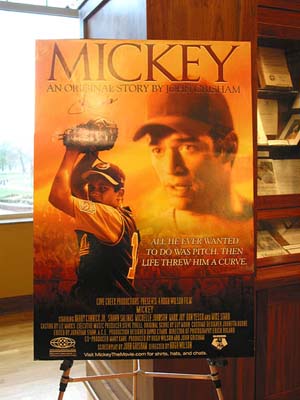
Photo of advertisement for film Mickey with original screen story by John Grisham. Poster is from John Grisham Room exhibit at MSU. Photo by N. Jacobs
- Link to all of Grisham’s books on his website
- The John Grisham Room at Mississippi State is an impressive, interesting place to visit.
- John Grisham’s official home page.
- John Grisham’s alma mater, Mississippi State Universiy, provides biography and links for its most famous graduate.
- Amazon.com interviews Grisham on his book The Brethren, his subjects, his literary influences, and more.
- Numerous reviews by many readers of The Rainmaker if you scroll down the page.
- Wikipedia page on A Time to Kill
Bibliography
- Bailey, Lolly. “It’s a time to read.” Desoto Times July 13, 1989 Sec. A: 4.
- Grisham, John. . ” John Grisham : A Self -Interview” USA Weekend (July 2, 1993): 2-4.
- Grisham, John. (1992). “Introduction.” Inside Dudy Noble—: A celebration of MSU Baseball. 5th ed. Ed. Steve Ellis. Louisville: Harmony House Publishers, 6.
- Grisham, John. “The best laid plans.” Mississippi State University Spring Commencement Exercises, Saturday, May 16, 1992: John Grisham’s Remarks to Graduates, Mississippi State, MS: The University.
- Grisham, John. “Journey’s end.” Mississippi State Alumnus 68 (Winter, 1991) 14-15.
- Kornegay, Jamie. “While waiting on Grisham’s third book, try the first one.” The Panolian , October 9, 1991 , 3.
- McDavid, Sammy. “A time to write.” Mississippi State Alumnus 65 (Winter, 1990): 13-16.
- Mitchell Memorial Library – John Grisham Papers. (1996). “For posterity.” Mississippi State University Libraries, Special Collections, Manuscripts Division, Mississippi State, MS: author, 1-4.
- Shirley, Aleda, Susan M. Glisson, and Ann J. Abadie, eds. Mississippi Writers II, Mississippi State, MS: Center for the Study of Southern Culture, 1995.
- Pate, Nancy. (1993) “Amid the best-selling chaos, John Grisham seeks a normal life.” The Birmingham News 6 June, sec. C: 1-2.
- Grisham, John; A Time to Kill. Wynwood Publishing, 1989.


